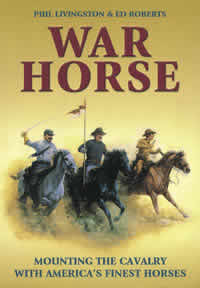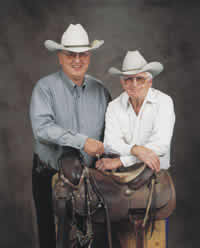 |
Authorse
reveal U.S. Remount Service had tremendous impact on horse
industry
Dedicated
horsemen lead the charge into military history with 'War Horse"
|
FORT
WORTH, Texas-Today's U.S. military pilots strike enemy targets at
supersonic speeds, while ground forces advance to the battlefront
in sophisticated tanks that can traverse practically any type of
terrain. In addition to their remarkable speed and range capabilities,
these stealthy fighters can often complete their missions before
they are ever detected by the enemy. Bring the U.S. Navy into the
theater, and the military possesses a triple threat by air, land
and sea that provides tremendous advantages during times of war.
 |
"War
Horse," a new 352-page book with more than 130 photographs,
gives readers a fascinating insight into the history of military
horses and discusses the major role these animals played in
shaping the breed standards so highly respected today. The book
cover was designed by legendary Western artist Chuck DeHaan.
It portrays a Confederate Army soldier from the Civil War, a
U.S. Cavalryman during the 1870s fighting in the Indian wars,
and a 1930s-era U.S. Cavalry sergeant. All the soldiers are
pictured on the sturdy, powerful mounts that typified military
horses. |
It
wasn't that long ago, however, that the horse supplied a strategic
advantage and played a major role in helping the Untied States to
defeat its enemies. From Revolutionary War times right on past the
Spanish-American war in 1898, skilled horsemen were riding their
strong mounts to victory, as the United States made steady progression
as a world power.
After
the turn of the 20th century, a group of knowledgeable and insightful
individuals, determined to maintain and ultimately enhance their
country's military advantage, devised a program to ensure that Americans
would always have enough horses ready for any fight at any time.
Strength in numbers was not their only concern. These military planners
were also committed to establishing a national stable of military
horses that were superior in intelligence, strength, stamina and
soundness than those of any other nation.
This
was the birth of the U.S. Remount Service, and is the primary focus
of a fascinating new book, titled "War Horse," written
by authors Ed Roberts and Phil Livingston.
The
compelling book gives just and long-overdue credit to the U.S. Remount
Service for achieving its military objectives and helping the nation
to maintain a strong defense.
Roberts
and Livingston detail how the U.S. Remount Service, from 1908 to
1948, met its goals of supplying hundreds of thousands of outstanding
horses for military use. Formed under the Quartermaster Corps of
the U.S. Army, the U.S. Remount Service actually established a special
program to make government stallions available to private mare owners
so they could develop a breeding pool of horses that could be called
into action at any given time.
 |
Ed
Roberts, left, and Phil Livingston have each spent a lifetime
in the horse industry. Their new book, "War Horse,"
combines a love of horses, history, education and writing for
the two men. (Photo by Photomedia, Fort Worth, Texas) |
Not
only was this program highly successful in serving the needs of
the military, the authors point out, but it had far-reaching benefits
to the U.S. economy and the horse industry as we know it today.
From
1914 to 1918 alone, according to Roberts and Livingston, the Army
purchased more than a half million horses at a cost of about $150
each, pumping an estimated $82.5 million into the agricultural economy.
In
addition, because of military's rigid requirements for the horses,
unprecedented standards were set for many of today's horses across
multiple breed lines.
"This
has probably been the best-kept secret in the horse industry,"
said Livingston, who has authored several successful equine books.
"These Remount studs were among the finest in the country.
And with the extensive breeding that was going on, they helped establish
a foundation of great horses. There are very few Paints, Palominos,
Quarter Horses and Appaloosas that cannot trace their lineage back
to these great studs. Not only that, but the Remount program vastly
increased the horse population-of not just horses, but great horses-and
we've been seeing the results from that for years."
Roberts
agreed. Once at the helm of the fastest-growing breed association
in the world-the American Paint Horse Association (APHA)-he has
seen the growth first-hand.
"Today's
horse industry, without a doubt, owes a lot to the war horse,"
Roberts said. "The large breeding pool that was established
by the U.S. Remount Service became the core of the superior stock
that helped shape some of our most popular breeds today."
To
back up their statements, the authors conducted extensive pedigree
research for "War Horse," which reads likes a who's who
of recent history's finest horses. They point out, for example,
that the heritage of Roy Rogers' "Trigger" can be traced
to the U.S. Remount Service breeding program.
These
pedigree records, along with chronologies, U.S. Remount Service
stallion listings and a wealth of sources, make "War Horse"
not only a compelling read, but a valuable research tool for professional
historians and history buffs alike.
"War
Horse" contains more than 130 archival photographs to illustrate
the insightful 352-page book.
The
authors spent 13 years researching documents, obtaining government
records, interviewing their subjects, tracking down photographs
and piecing the information together.
"We
found that not much had been written on this subject and we wanted
to assemble as much information as possible" said Roberts.
"The war horse story, especially as it relates to the U.S.
Remount Service, is one that we really wanted to be told."
Both
Roberts and Livingston became fascinated with military mounts as
youngsters. For Roberts, he has vivid memories of watching the U.S.
Cavalry on maneuvers at Fort Sill in Lawton, Oklahoma, in the 1930s.
He was captivated by the beauty and athleticism of the horses. For
Livingston, the son of a cavalry officer who served in World War
I, World War II and Korea, the interest began while riding a military
horse in China when his father was stationed there.
The
two men have dedicated much of their lives to working in the horse
industry.
Roberts
served as APHA executive secretary for 26 years, from 1975 to 2001,
leading the association and the American Paint Horse breed to world-wide
prominence. He presently serves as APHA's director of long-range
planning. Before coming to APHA, Roberts developed the youth program
for the Appaloosa Horse Club, and also worked as a teacher after
graduating from Oklahoma State University. A rancher and horseman,
Roberts is a valued member of the American Horse Council.
Livingston
has served as editor the Paint Horse Journal and the Western Livestock
Journal. Also a rancher and horseman, Livingston is an accomplished
journalist and author with a long list of outstanding horse-related
features and books to his credit. He is widely respected as both
a writer and a historian. Livingston attended California Polytechnic
State University, San Luis Obispo.
"War
Horse" is available from Bright Sky Press by calling toll-free
(866) 933-6133. You can also visit the publisher's Web site at www.brightskypress.com.
Visit
http://www.apha.com for more information.
.
|







